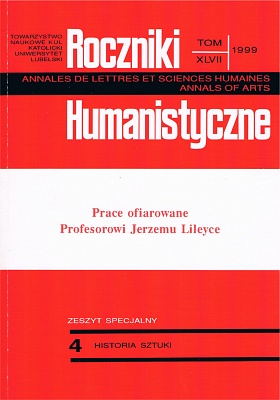Decoration by Jan Henryk Rosen of the Memorial Chapel of St. Catherine's Military School in Anaheim (California)
Abstract
The chapel was built by architect Jerzy Szeptycki in the years 1956-1958. It had already been decided that the decoration of the chapel was to be done by Jan Henryk Rosen (1891-1982) according to the theological conception of Prelate Walerian Jasiński from Orchard Lake. The chapel is made up of a spacious nave based on a rectangular plan. The right (northern) side elevation was designed in the context of Rosen's mosaic made by the artist in 1959. The mosaic is devoted to the champions of truth from the beginning of our civilization and presents those who had lived before the establishment of the Church. On our left we see Hammurabi, Amenophis IV, Cyrus, Hippocrates, Socrates, Plato, Phidias, Aristotle, Ptolemy, Seneca, Plotinus, Avicenna, Averroes and Maimonides. This succession of wise men changes direction toward the third, center segment and the frontally presented Boethius and St. John the Baptist. Moving toward the center we a so see the prophets of the Old Testament: Isaiah, Elijah, Salomon, David, Moses and Abraham (right segment). On the presbytery side narrow rectangular segments hold the figures of St. Thomas Aquinas and the personification of the four elements. The internal decor further develops the rich doctrinal agenda. On the right wall is Rosen's fresco Descent of Divine Truth. The central figure is Christ teaching the eternal truths. On the presbytery side - St. Joan of Arc, St. Teresa of Avila, Blessed Jane of Aza, St. Catherine of Siena, St. Gertrude the Great, St. Monica and St. Elizabeth are depicted. Between the alter and the dominating figure of Christ is the head of St. John Baptist. On the other side of the chapel can be seen St. John the Evangelist, St. Peter, St. Paul, St. Athanasius, St. Augustine, St. Gregory the Great, St. John Damascene, St. Thomas Aquinas, St. Bonaventura, Dante Alighieri, Virgil − overhead is a star representing Beatrice, Nicholas Copernicus, St. Ignatius of Loyola, St. Pope Pius V, St. Francis de Sales, Leo XIII, Cardinal Mercier, St. Anthony of the Desert, Fra Angelico and in addition various symbols and architectural motifs decorate the background of the frescoes. While the figures on the outside wall are presented in profile as in Egyptian art, the figures on the inside wall are frontal views in classical and Byzantine tradition. Rosen also designed the mosaic (though actually made in an Italian workshop) on the presbytery wall. The crucial element organizing the spatial and decorative interior of the chapel are the stained glass windows created by the Frenchman Max Ingrand according to the drawings of Rosen. Translated by Christopher O'Neill.
Copyright (c) 1999 Roczniki Humanistyczne

This work is licensed under a Creative Commons Attribution-NonCommercial-NoDerivatives 4.0 International License.





